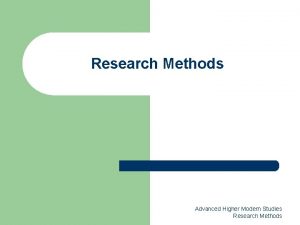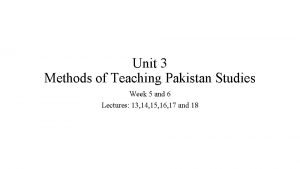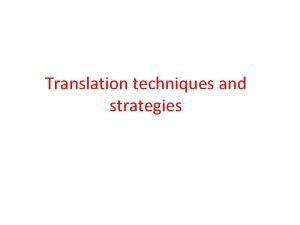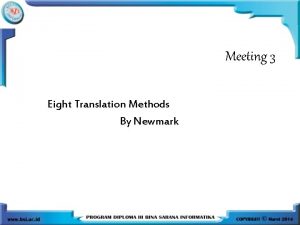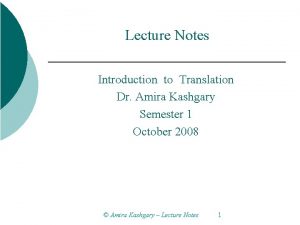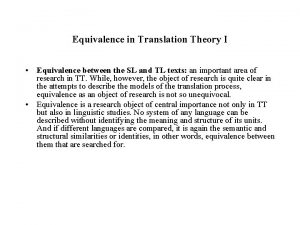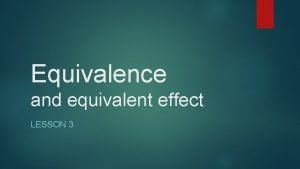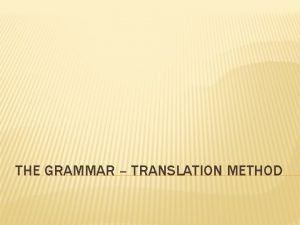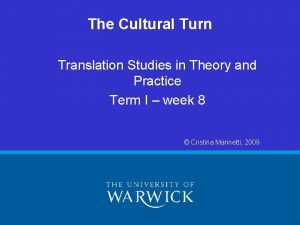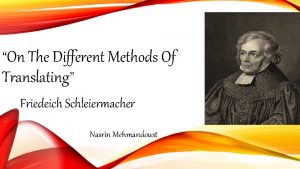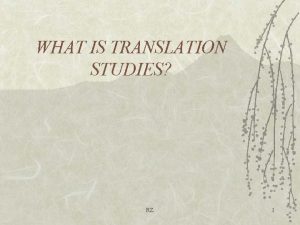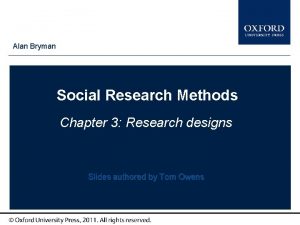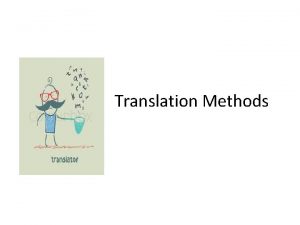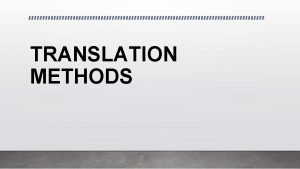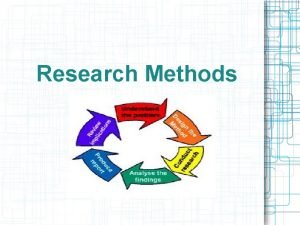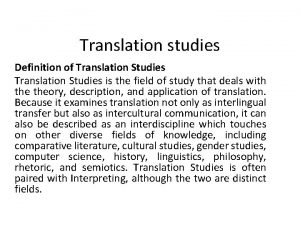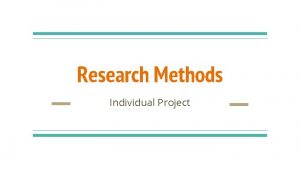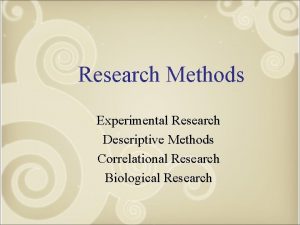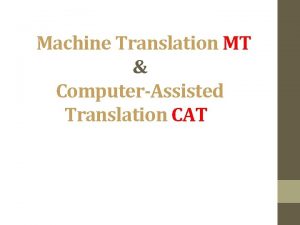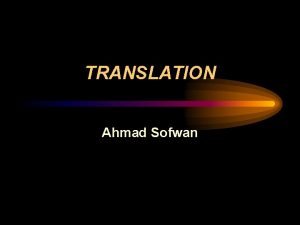Translation Studies 8 Research methods in Translation Studies














- Slides: 14

Translation Studies 8. Research methods in Translation Studies Krisztina Károly, Spring, 2006 Sources: Károly, 2002; Klaudy, 2003

8. 1. Empirical methods (Klaudy, 2003) Translation research: in 3 directions the product (subject = reader) the process (subject = translator) the function (subject = reader)

Product-oriented methods of data collection (to measure readability): (1) The cloze test effective in measuring language proficiency in general and the reading skill in particular prepared by deleting every nth word from a continuous stretch of text, and the reader has to fill in the missing words do not only measure how well students understand texts, but they can also show understandable the text is capable of measuring the readability of translated texts

Problems of cloze tests: the readability/comprehensibility of a TL text produced as a result of translation cannot be assessed independently, only in comparison or relative to other texts (SL text or other TL texts) it is maybe more beneficial to compare the different translations of the same text with the help of a clozetest

(2) The questionnaire to measure readers' reactions: readers, having gone through the translation(s), write down their intuitive impressions about the text(s) read possible areas of use (Klaudy’s experiments): (a) to judge whether a text was an original Hungarian text or a translation as a part of an experiment to demonstrate the phenomenon of so called “quasicorrectness” in translated Hungarian texts (b) to explore how e. g. explicitation affects readers' perceptions of the translations

Questionnaire cont. types of questions asked in (a) (after having read the texts at usual speed): (1) Do you think the above text is an original text or a translation? (decision) (2) How do you know? (explanation) (3) If you believe it is a translation, how would you rate it? (evaluation) types questions asked in (b) (aim=how one type of explicitation, addition, affects the readability): (1) First part of the questionnaire (global reading): participants were asked to read the two translations and decide whether they perceived any differences between the two versions, and if so, which translation they considered to be better. (2) Second part (text analysis): they had to find additions in both translations.

Process-oriented method: Introspection (Think-aloud protocols) to investigate thinking processes during translation (first used by Hans Krings, 1986) asks L learners to speak into a tape recorder and tell everything that comes into their minds while translating; recordings are transcribed (=think aloud protocols) and analysed according to various criteria possible areas of investigation: determining the proportion of automatic and nonautomatic thinking processes; editing, etc.

8. 2 Corpus-based research methods Key concepts (Károly, 2002): corpus: "A corpus is a body of text assembled according to explicit design criteria for a specific purpose. " (Atkins & Clear, 1992, p. 5) learner corpus: "… computer textual data base of the language produced by foreign language learners. " (Leech, 1998, p. xiv)

Key concepts cont. corpus annotation: "… the practice of adding interpretative (especially linguistic) information to an existing corpus of spoken and/or written language by some kind of coding attached, or interpersed with, the electronic representation of the language material itself. " (Leech, 1993, p. 275) tagged - untagged corpus concordancing programs: allow the user to search for specific target words in a corpus, providing exhaustive lists for the occurrences of the word in context (Figure 1) and frequency information (Figure 2) (Biber, Conrad, & Reppen, 1998, p. 29)

Figure 1: Sample Key Word in Context (KWIC) concordance listings for deal (Biber, Conrad, & Reppen, 1998, p. 27) and secret plans prepared to deal with the mass sit-down of companies and put one property deal through each. Mr. . In particular, a good deal of concern has been hangs a tale - and a great deal of money. Neville where his new measures to deal with Britain's just a matter of working a good deal harder before we really. "I'm mixed up in a deal involving millions

Figure 2: Frequency list of forms of deal (from the LOB Corpus: 1 million words) (Biber, Conrad, & Reppen, 1998, p. 29) deal …………………. . 182 dealing ………………. 52 deals …………………. 25 dealt …………………. . 31

Criteria of corpora (Klaudy, 2003): (1) It must be a collection of texts that can be read by machine and is thus analysable automatically or semi-automatically. (2) A corpus may include not only written texts, but also spoken discourse. (3) A corpus is not the work of a single author, but it is a collection of texts from various sources and on various topics (it does not even have to be a continuous piece of text), the only important thing is that it must be compiled on the basis of pre -established criteria.

Selection criteria for corpus design (Baker, 1995): (1) general language vs. restricted domain (2) written vs. spoken language (3) synchronic vs. diachronic (4) typicality in terms of range of sources (writers/speakers) and genres (e. g. newspaper editorials, radio interviews, fiction, journal articles, court hearings) (5) geographical limits. e. g. , British vs. American English (6) monolingual vs. bilingual or multilingual” (Baker 1995: 229)

Types of corpora Multilingual corpora: similar text types in several languages Bilingual corpora: -parallel: source text and its translation in another L (may be bi-directional), -comparable ( translated texts): texts spontaneously produced in two languages in similar circumstances and within the same domains Monolingual (comparable) corpora: authentic/original texts and translated texts in the same language Translation corpora: consisting of only translations ***
 Advanced higher modern studies essay structure
Advanced higher modern studies essay structure Wax pattern fabrication
Wax pattern fabrication Textbook method for teaching of pakistan studies
Textbook method for teaching of pakistan studies Translation methods and strategies
Translation methods and strategies Faithful translation method
Faithful translation method Methods of translation exposure
Methods of translation exposure Paradigm shift from women studies to gender studies
Paradigm shift from women studies to gender studies Translation studies lecture notes
Translation studies lecture notes Otto kade translation
Otto kade translation Formal equivalent
Formal equivalent The grammar translation method advantages and disadvantages
The grammar translation method advantages and disadvantages Cultural turn in translation studies
Cultural turn in translation studies Friedeich
Friedeich Wolfram wills
Wolfram wills Alan bryman social research methods
Alan bryman social research methods
